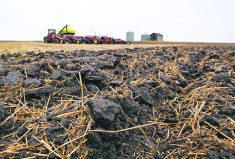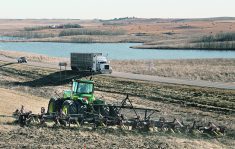Like their Canadian counterparts, American farmers will soon have more funding available to adopt climate-friendly production practices.
The United States is aiming to reduce its environmental footprint and decrease its deficit at the same time in a bid to cool rapidly rising inflation rates.
On Aug. 7, the U.S. Senate unanimously passed the Inflation Reduction Act of 2022, which will provide about US$370 billion in energy security and climate change programs over the next 10 years.
Some $40 billion of that is earmarked to help the U.S. agriculture sector mitigate climate change and improve farm resilience against extreme weather events.
Read Also

Kochia has become a significant problem for Prairie farmers
As you travel through southern Saskatchewan and Alberta, particularly in areas challenged by dry growing conditions, the magnitude of the kochia problem is easy to see.
The money will largely come from revenue raised by implementing a corporate minimum tax rate, tax enforcement and closing tax loopholes, according to a summary of the Act. The U.S. government estimated it will raise $739 billion through this tax reform, and after the investment in climate change initiatives, it estimates it will have at least $300 billion left over to reduce the federal deficit.
In the Act summary, the Democrats said it’s “a historic down payment on deficit reduction to fight inflation, invest in domestic energy production and manufacturing and reduce carbon emissions by roughly 40 percent by 2030.”
It’s important to note here that the 40 percent goal is not targeted specifically at agriculture — it involves all sectors, including manufacturing, oil and gas.
It’s a lofty goal and a unique approach. It’s also a clear signal that the administration of U.S. President Joe Biden is dedicated to reducing the effects of climate change.
Last February, the U.S. Department of Agriculture held its annual Agricultural Forum. According to a summary by law firm Holland & Knight, USDA Secretary Tom Vilsack and many of his colleagues “stressed the need to deploy new technologies and time-tested practices to meet the challenge of increasing agricultural productivity, while reducing agriculture’s environmental impact and contributions to greenhouse gas emissions.”
Forum sessions highlighted the need for programs and financial assistance to help U.S. farmers be more prepared for extreme weather, cope with drought risk, contribute to biofuel production, help develop forest resilience and adopt sustainable agriculture practices such as the use of cover crops and reduced tillage, the summary indicated.
Although light on specifics regarding climate change program roll out, the Democrats provide a breakdown of how funds will be spent in a one-page summary. Highlights include a funding boost for existing conversation practices, which now only provide enough funding for one-third of applicants.
About US$4 billion will fund the Bureau of Reclamation’s efforts to combat drought in the western U.S., with particular emphasis on the Colorado river basin.
The agriculture provisions of the Act include $8.45 billion in new funds to help farmers adopt stewardship practices, as well as nearly $5 billion annually to fund several stewardship programs.
Another $14 billion is slated to support rural electric co-operatives, communities and farmers’ transition to cleaner or renewable energy, and some money will go toward building infrastructure for home-grown biofuel production.
It will be important to see how the latter rolls out. The Biden administration has been accused of being short-sighted when it comes to biofuels, particularly ethanol derived from corn. A paper penned by researchers at the University of Wisconsin-Madison on the Renewal Fuel Standard wrote “…corn ethanol is not a climate-friendly fuel and we need to accelerate the shift toward better renewable fuels, as well as make improvements in efficiency and electrification.”
The researchers found that the biofuel standard increased corn prices by about 30 percent, while other commodity crop prices decreased, and it spurred corn production.
If the U.S. is to reach its 40 percent carbon emissions reduction goal in the next eight years, funding this does not make a lot of sense.
The Act still has to pass a House vote at the time of writing this column. But the tone is set for the development of the next U.S. Farm Bill, which expires in September 2023.
Kristy Nudds is the Editor of Farmtario, a regional agricultural newspaper in Ontario.





![Protesters crowd a street carrying signs that read, "Global warming real. In other news, water is wet," and "Stop denying the [blue painted pic of the Earth] is dying."](https://static.producer.com/wp-content/uploads/2025/07/29145152/158171_web1_2019-10-18T222818Z_1221762151_RC14C26A65A0_RTRMADP_3_CLIMATE-CHANGE-THUNBERG-1200-220x165.jpg)











